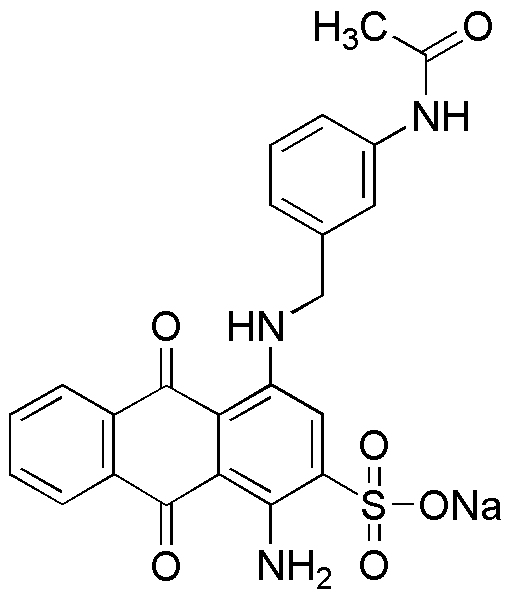Acid Blue 40 is widely utilized in research focused on:
- Dyeing and Textile Industry: This chemical is primarily used as a dye for various fabrics, providing vibrant colors that are resistant to fading. Its application in textiles ensures long-lasting color quality, making it a preferred choice for manufacturers.
- Food Industry: Acid Blue 40 serves as a food coloring agent, enhancing the visual appeal of products like candies and beverages. Its use complies with food safety regulations, ensuring it is safe for consumption.
- Biological Research: In laboratories, it is used as a staining agent for microscopy, helping researchers visualize cellular structures and processes. This application is crucial for studies in cell biology and histology.
- Cosmetics: The compound is also found in various cosmetic products, providing color to items such as makeup and hair dyes. Its stability and safety make it a popular choice in the beauty industry.
- Pharmaceuticals: Acid Blue 40 is used in certain pharmaceutical formulations, primarily as a coloring agent. This enhances product identification and can improve patient compliance by making medications more visually appealing.
General Information
Properties
Safety and Regulations
Applications
Acid Blue 40 is widely utilized in research focused on:
- Dyeing and Textile Industry: This chemical is primarily used as a dye for various fabrics, providing vibrant colors that are resistant to fading. Its application in textiles ensures long-lasting color quality, making it a preferred choice for manufacturers.
- Food Industry: Acid Blue 40 serves as a food coloring agent, enhancing the visual appeal of products like candies and beverages. Its use complies with food safety regulations, ensuring it is safe for consumption.
- Biological Research: In laboratories, it is used as a staining agent for microscopy, helping researchers visualize cellular structures and processes. This application is crucial for studies in cell biology and histology.
- Cosmetics: The compound is also found in various cosmetic products, providing color to items such as makeup and hair dyes. Its stability and safety make it a popular choice in the beauty industry.
- Pharmaceuticals: Acid Blue 40 is used in certain pharmaceutical formulations, primarily as a coloring agent. This enhances product identification and can improve patient compliance by making medications more visually appealing.
Documents
Safety Data Sheets (SDS)
The SDS provides comprehensive safety information on handling, storage, and disposal of the product.
Product Specification (PS)
The PS provides a comprehensive breakdown of the product’s properties, including chemical composition, physical state, purity, and storage requirements. It also details acceptable quality ranges and the product's intended applications.
Certificates of Analysis (COA)
Search for Certificates of Analysis (COA) by entering the products Lot Number. Lot and Batch Numbers can be found on a product’s label following the words ‘Lot’ or ‘Batch’.
*Catalog Number
*Lot Number
Certificates Of Origin (COO)
This COO confirms the country where the product was manufactured, and also details the materials and components used in it and whether it is derived from natural, synthetic, or other specific sources. This certificate may be required for customs, trade, and regulatory compliance.
*Catalog Number
*Lot Number
Safety Data Sheets (SDS)
The SDS provides comprehensive safety information on handling, storage, and disposal of the product.
DownloadProduct Specification (PS)
The PS provides a comprehensive breakdown of the product’s properties, including chemical composition, physical state, purity, and storage requirements. It also details acceptable quality ranges and the product's intended applications.
DownloadCertificates of Analysis (COA)
Search for Certificates of Analysis (COA) by entering the products Lot Number. Lot and Batch Numbers can be found on a product’s label following the words ‘Lot’ or ‘Batch’.
*Catalog Number
*Lot Number
Certificates Of Origin (COO)
This COO confirms the country where the product was manufactured, and also details the materials and components used in it and whether it is derived from natural, synthetic, or other specific sources. This certificate may be required for customs, trade, and regulatory compliance.


